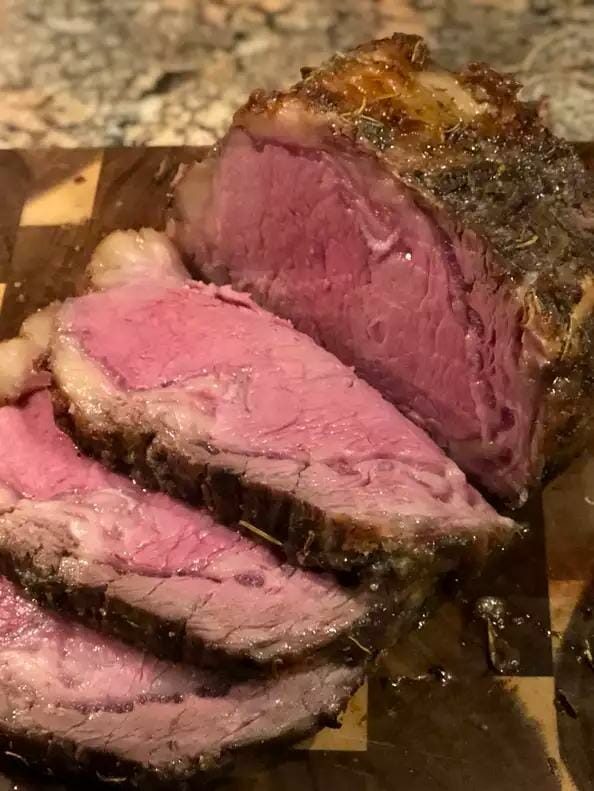AT THIS POINT YOU MAY OPEN THE OVEN DOOR. **If your roast temperature is a bit cooler than 130° -135° F, simply preheat your oven to 375° F., returning the roast to the oven until the internal temperature reaches 130° -135° F, checking the internal temperature every so often until the prime rib raises a few more degrees to the desired temperature. When the proper temperature is achieved, snip the strings that are holding the bone rack to the prime rib roast (if it has string). Using big forks, lift the prime rib roast from the rib rack and the roasting pan, placing it onto a large cutting board. Once the roast has reached the temperature you want, remove it from the oven and place it on a carving board. Cover it with foil and let it rest for 5-10 minutes before carving. Serving the Prime Rib Slice the prime rib into thick slices, placing them on a platter or onto dinner plates. Pour a bit of the warm au jus over the prime rib. Serve at once. Set out the au jus and a creamy horseradish sauce on the table for passing. Keep a pan of simmering beef stock in case someone feels their prime rib needs more cooking. THE AU JUS ¼ cup Pan drippings from prime rib 1 Tbsp. Butter 2 Tbsp. All-purpose Flour 3 Cups Beef Stock 1/2 tsp. Worcestershire sauce Sea Salt, To Taste Black Pepper, To Taste Add the beef drippings and butter to a medium saucepan. Bring to a simmer over medium heat. Sift the flour over the drippings/butter and whisk for 30-45 seconds. Add 1 cup of beef stock and whisk to combine. Slowly pour in the remaining beef stock while continuing to whisk. Increase the heat to medium-high and add the Worcestershire sauce, whisk to combine. Simmer for 4 minutes, allowing to reduce. Taste and add black pepper but only add salt if needed. Notes • Before Purchasing Roast: When you are ready to purchase your roast, please find a local butcher, go see them, and talk with them. Tell them the full story of what you are planning so they understand the big picture. Let them know what you’re trying to accomplish, how many people you’re serving, etc. They will guide you and take the guesswork out. • Levels of Doneness: Different areas of the finished prime rib will have different temperatures which means that those who like rare will be happy and those who will not eat pink will also be happy. Prime rib is a crowd pleaser in so many ways! • Important Temperature Information: Determining when the prime rib is done is not difficult, but you must have a good meat thermometer – I cannot say this enough – the ideal level for prime rib is rare or medium rare. When you determine the level that you want to achieve, use the meat thermometer to monitor the internal temperature so you know when it has reached the appropriate temp. Always remember, you cannot un-cook the meat, but you can cook it longer if needed. Following are the internal temperatures to keep in mind. For a rare roast: 115°F. For medium rare: 120°F. For a medium: 130°F. • Cooking Time: Keep in mind that the actual cooking time will depend on the size and shape of the roast, if it is room temperature when it goes into the oven, and the particular oven you will use and how it heats. A flatter roast will cook more quickly than a thicker one. A chilled roast will take more time to cook than one that is at room temperature. • Let the Roast Rest Once the roast has reached the temperature you want, remove it from the oven and place it on a carving board. Cover it with foil and let it rest for 5-10 minutes before carving.
ADVERTISEMENT

